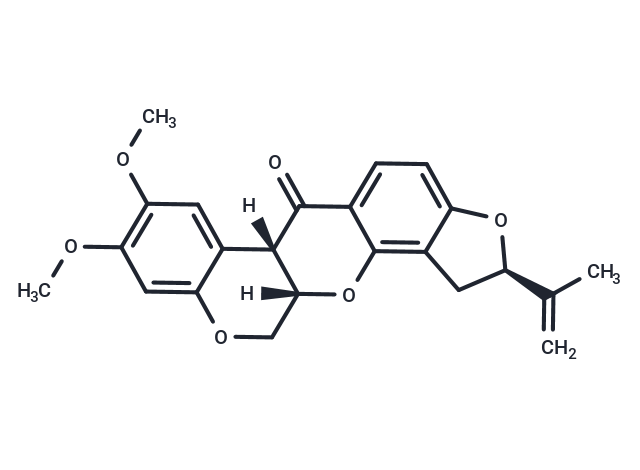Shopping Cart
- Remove All
 Your shopping cart is currently empty
Your shopping cart is currently empty

Rotenone (Rotocide) is a natural product and a botanical insecticide. Rotenone is a mitochondrial electron transport complex I inhibitor that promotes the production of reactive oxygen species in mitochondria and induces apoptosis.

| Pack Size | Price | Availability | Quantity |
|---|---|---|---|
| 500 mg | $42 | In Stock | |
| 1 g | $50 | In Stock | |
| 5 g | $89 | In Stock | |
| 1 mL x 10 mM (in DMSO) | $46 | In Stock |
| Description | Rotenone (Rotocide) is a natural product and a botanical insecticide. Rotenone is a mitochondrial electron transport complex I inhibitor that promotes the production of reactive oxygen species in mitochondria and induces apoptosis. |
| In vitro | METHODS: Human leukemia cells HL-60 were treated with Rotenone (0-1000 nM) for 30 min and oxygen consumption was measured using a Clark oxygen electrode. RESULTS: Rotenone dose-dependently inhibited HL-60 cell respiration. Rotenone inhibited cellular respiration by more than 96% at 500 nM. [1] METHODS: 10th DIV cells were treated with Rotenone (20 nM) for 48 h. LDH levels were measured by LDH release assay. RESULTS: LDH release can be used as an indicator of general cytotoxicity. rotenone induced an increase in LDH release, and LDH activity increased more than 6-fold compared to the control group. LDH activity increased more than 6-fold compared to the control group.[2] |
| In vivo | METHODS: To establish a reproducible mouse model of Rotenone-induced Parkinson's disease (PD), Rotenone (2.5 mg/kg) was administered intraperitoneally to C57Bl/6 mice once daily for two weeks. RESULTS: Systemic exposure of mice to Rotenone resulted in progressive accumulation and regional spread of p129 aggregates, which preceded the maximal loss of DAn. [3] METHODS: To study neurotoxicity, Rotenone (30-100 mg/kg) was administered orally to C57BL/6 mice once daily for fifty-six days. RESULTS: The survival of Rotenone-treated mice at 30 mg/kg was unchanged from 28-56 days, although the survival of Rotenone-treated mice was reduced to approximately 70% within one week. 100 mg/kg Rotenone-treated mice showed a sudden decrease in survival after 28 days, and ultimately to approximately 15% after 56 days. A regimen of Rotenone given chronically at 30 mg/kg for 56 days is more useful for understanding the mechanisms of DA neurodegeneration. [4] |
| Alias | Rotocide, Rotenon, Paraderil, Dactinol, Barbasco |
| Molecular Weight | 394.42 |
| Formula | C23H22O6 |
| Cas No. | 83-79-4 |
| Smiles | O=C1C=2C(=C3C(O[C@@H](C(C)=C)C3)=CC2)O[C@]4([C@@]1(C=5C(OC4)=CC(OC)=C(OC)C5)[H])[H] |
| Relative Density. | 1.27(20°C) |
| Storage | keep away from direct sunlight,store at low temperature,store under nitrogen | Powder: -20°C for 3 years | In solvent: -80°C for 1 year | Shipping with blue ice. | |||||||||||||||
| Solubility Information | DMSO: 18.33 mg/mL (46.48 mM), Sonication is recommended. 10% DMSO+40% PEG300+5% Tween 80+45% Saline: 3.94 mg/mL (9.99 mM), suspension.In vivo: Please add the solvents sequentially, clarifying the solution as much as possible before adding the next one. Dissolve by heating and/or sonication if necessary. Working solution is recommended to be prepared and used immediately. | |||||||||||||||
Solution Preparation Table | ||||||||||||||||
DMSO
| ||||||||||||||||

Copyright © 2015-2025 TargetMol Chemicals Inc. All Rights Reserved.